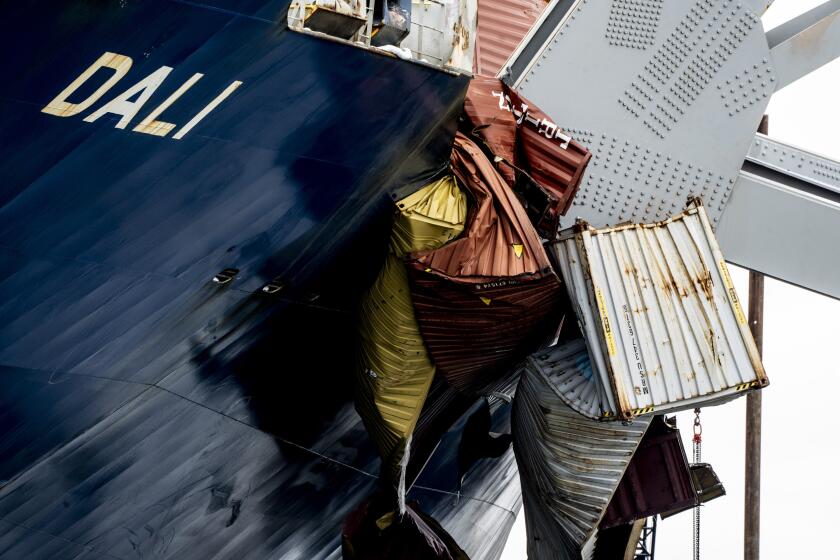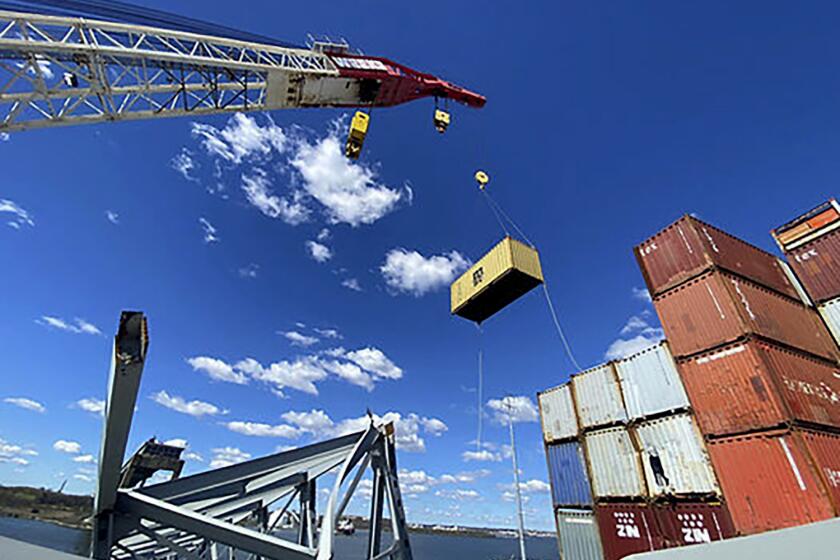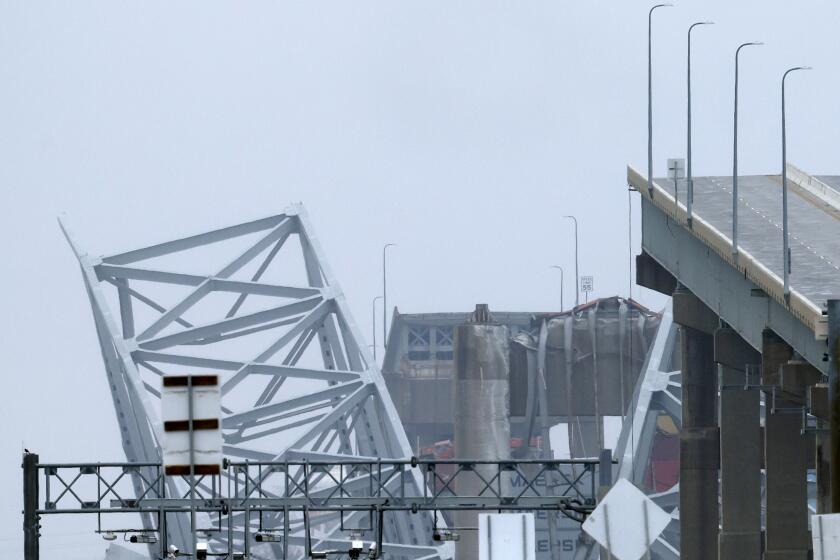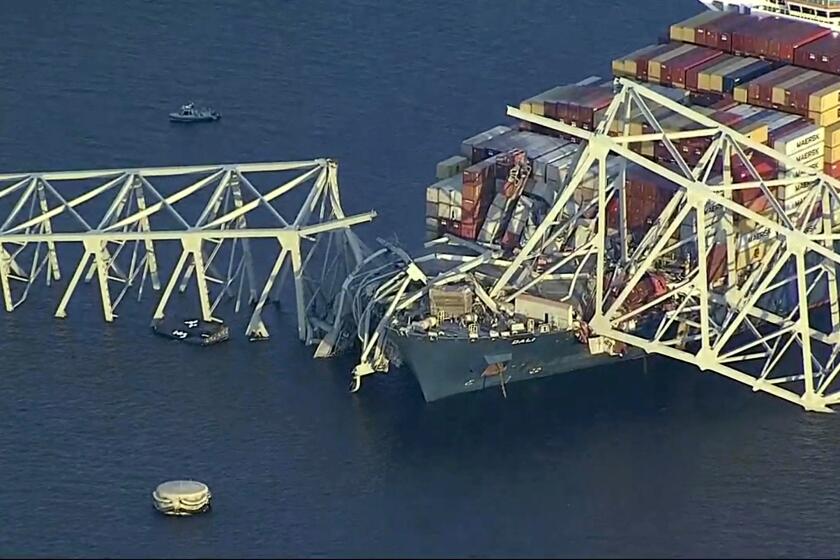New deep-water channel allows first ship to pass Key Bridge wreckage in Baltimore
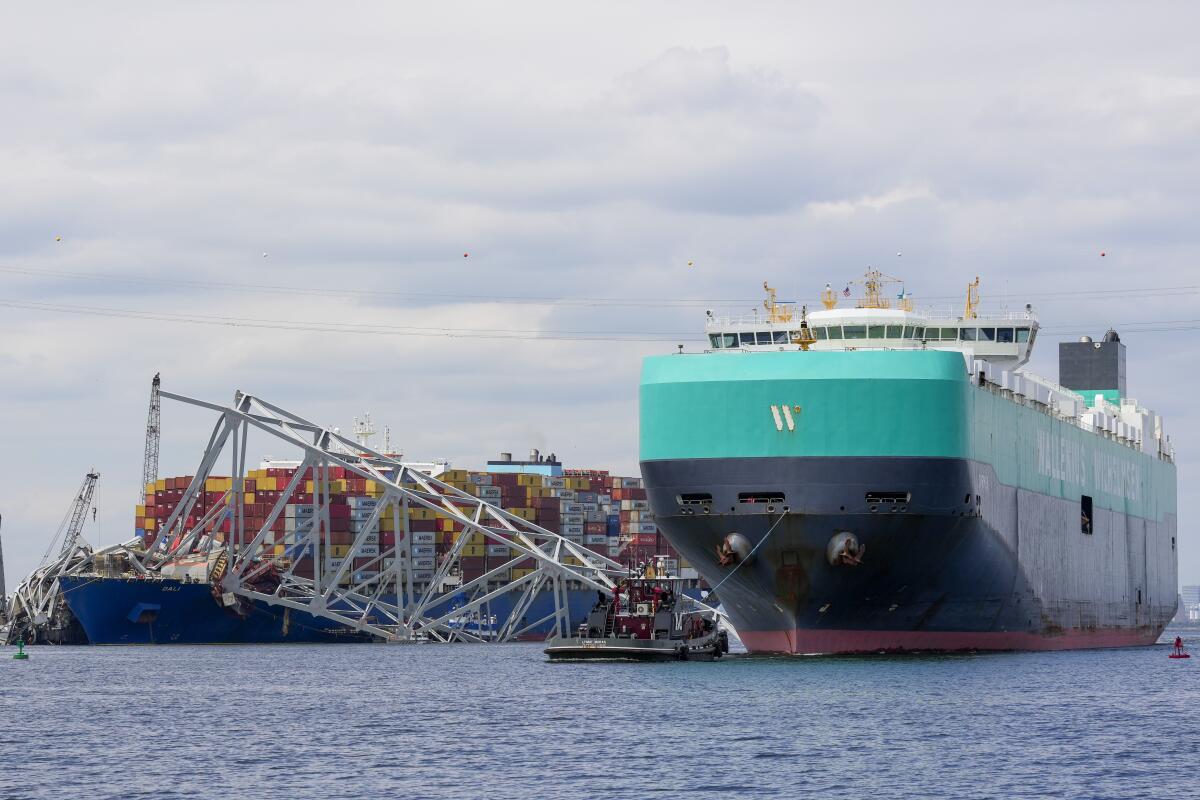
- Share via
BALTIMORE — The first cargo ship passed through a newly opened deep-water channel in Baltimore this week after being stuck in the harbor since the Francis Scott Key Bridge collapsed four weeks ago, halting most maritime traffic through the city’s port.
The Balsa 94, a bulk carrier sailing under a Panama flag, passed through the new 35-foot channel Thursday, headed for St. John, Canada. Two more commercial ships followed later that day, including a vehicle carrier headed to Panama.
Their long-awaited voyages marked an important step in the ongoing cleanup and recovery effort as crews have been working around the clock to clear thousands of tons of mangled steel and concrete from the entrance to Baltimore’s harbor.
Five vessels that have been stranded for weeks are expected to finally leave Baltimore through the new, temporary channel. Other ships are scheduled to enter the port, which normally processes more cars and farm equipment than any other in the country.
A fuel barge has become the first vessel to use an alternate channel to bypass the wreckage of Baltimore’s collapsed Francis Scott Key Bridge.
Thousands of longshoremen, truckers and small-business owners have seen their jobs affected by the collapse, prompting local and state officials to prioritize reopening the port and restoring its traffic to normal capacity in hopes of easing the economic ripple effects of the collapse. Officials have also established various assistance programs for unemployed workers and others affected by the closure.
On Thursday morning, the Balsa 94 moved through the channel guided by two tugboats, one in front and one behind. It glided slowly past the fallen bridge and grounded Dali, the massive container ship that caused the collapse when it slammed into one of the bridge’s support columns.
Pieces of the steel span are still blocking other parts of the port’s main channel, which has a controlling depth of 50 feet, enough to accommodate some of the largest cargo and cruise ships on the water.
Salvage crews have begun removing containers from the cargo ship that crashed into and collapsed the Francis Scott Key Bridge in Baltimore.
The Balsa 94 is expected to arrive in Canada on Monday.
The Dali lost power and veered off course shortly after leaving the Port of Baltimore bound for Sri Lanka last month.
Six members of a roadwork crew — all Latino immigrants from Mexico, Guatemala, El Salvador and Honduras — plunged to their deaths in the collapse. Four bodies have been recovered from the underwater wreckage; two remain missing.
A memorial for the victims near the south end of the bridge has grown in recent weeks. It now includes six large wooden crosses decorated with flags from the victims’ home countries and other personal items, including the hardhats and work boots that allowed them to provide for their families and chase the American dream. A painted canvas backdrop displays abstract scenes from the bridge collapse and salvage efforts as well as handwritten notes from the men’s loved ones.
Cleanup the wreckage of the collapsed Francis Scott Key Bridge in Baltimore begins and authorities announce suspension of the search for four workers.
“We want to send a message to the world that we’re here and we care,” said the artist, Roberto Marquez, who was visiting the memorial late Thursday morning. “We will be here working until they are all recovered.”
The new channel will remain open until Monday or Tuesday and then close again until roughly May 10. During the closure, crews will work to remove steel spans from the deck of the Dali and refloat the ship, which will then be guided back into the port, officials said this week.
The port’s main channel is set to reopen next month after the Dali has been removed from the collapse site. That will allow for a normal flow of traffic to resume through the port.
But for now, the 35-foot depth is a substantial increase over the three other temporary channels established in recent weeks. It puts the cleanup effort slightly ahead of schedule, as officials previously said they hoped to open a channel of that depth by the end of April.
A hulking vehicle carrier named Carmen that is nearly as long as the Dali became the third commercial ship to traverse the channel Thursday afternoon. Viewed from the deck of a nearby passenger boat, it appeared to sail steadily between the marker buoys, dwarfing the cranes, barges and other wreckage removal equipment that was stationed nearby.
Immigrants built America, but some politicians and pundits would like us to believe that the great contributions of immigrants stopped somewhere in the late 1800s.
Even with commercial ships chugging past, crews continued the arduous process of clearing debris from the collapse site. On Thursday, they were using a crane apparatus to smash the fallen roadway into more manageable pieces that could be lifted from underwater with a giant claw.
In a court filing Monday, Baltimore’s mayor and City Council called for the Dali’s owner and manager to be held fully liable for the bridge collapse, which they said could be devastating for the regional economy. They said the port, which was established before the nation’s founding, has long been an economic driver for Baltimore and the surrounding area. Losing the bridge itself has also disrupted a major East Coast trucking route.
The filing came in response to an earlier petition on behalf of the two companies asking a court to cap their liability under a pre-Civil War provision of a maritime law — a routine procedure for such cases. A federal court in Maryland will ultimately decide who’s responsible and how much they owe.
In the meantime, the FBI and the National Transportation Safety Board are conducting probes to determine what caused the ship to lose power and strike the bridge.
Skene writes for the Associated Press.
More to Read
Sign up for Essential California
The most important California stories and recommendations in your inbox every morning.
You may occasionally receive promotional content from the Los Angeles Times.
